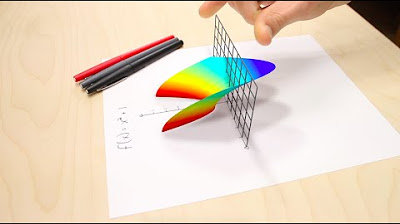Real Numbers
Summary
TLDRThis video introduces the concept of real numbers, distinguishing them from imaginary numbers. It explains that real numbers can be categorized into rational and irrational numbers. Rational numbers include integers, whole numbers, and fractions, while irrational numbers cannot be expressed as fractions and have non-repeating, non-terminating decimals. The video also covers key mathematical concepts, such as square roots, cube roots, and how to classify numbers based on their properties. Real numbers, whether rational or irrational, can all be plotted on a number line.
Takeaways
- 😀 Real numbers are numbers that can be plotted on a number line, unlike imaginary numbers.
- 😀 Imaginary numbers, such as 'i', are based on the square root of negative numbers and cannot be represented on a number line.
- 😀 Real numbers are divided into two categories: rational and irrational numbers.
- 😀 Rational numbers can be expressed as a fraction of two integers, such as 3/4 or 0.75.
- 😀 Whole numbers start from 0 and include positive integers (0, 1, 2, 3, ...), while natural numbers start from 1 (1, 2, 3, ...).
- 😀 Integers include all whole numbers and their negative counterparts (e.g., -3, -2, -1, 0, 1, 2, 3, ...).
- 😀 Irrational numbers cannot be expressed as fractions of two integers and include numbers like the square root of 2, pi, and e.
- 😀 Rational numbers can have either terminating decimals (e.g., 0.375) or repeating decimals (e.g., 0.333...).
- 😀 Examples of irrational numbers include non-terminating, non-repeating decimals like pi (3.14159...) and the square root of 2.
- 😀 Square roots, cube roots, and other roots can result in either rational or irrational numbers depending on whether they simplify to integers or not.
Q & A
What are real numbers?
-Real numbers are any numbers that can be plotted on a number line, and they exclude imaginary numbers. They include both rational and irrational numbers.
What distinguishes imaginary numbers from real numbers?
-Imaginary numbers involve the square root of negative numbers, such as 'i', which represents the square root of -1. Real numbers do not involve the square root of negative values.
What is the square root of -1 and why can't it be plotted on a number line?
-The square root of -1 is represented by 'i', which is an imaginary number. Imaginary numbers cannot be plotted on a number line because they don’t have a position in the real number system.
What are rational numbers, and how can they be expressed?
-Rational numbers are numbers that can be expressed as a fraction of two integers (a/b), where both 'a' and 'b' are integers. Examples include 3/4, -5/2, and 0.75.
How can you express the decimal 0.15 as a fraction, and what does this reveal about it?
-0.15 can be written as the fraction 15/100, which simplifies to 3/20. This shows that 0.15 is a rational number because it can be expressed as a fraction of integers.
What is the difference between rational and irrational numbers?
-Rational numbers can be written as fractions of two integers, while irrational numbers cannot. Irrational numbers have non-repeating and non-terminating decimals, like pi or the square root of 2.
Why are the square root of 2 and pi considered irrational numbers?
-Both the square root of 2 and pi are irrational because their decimal expansions do not repeat or terminate. The square root of 2 is approximately 1.414213, and pi is approximately 3.14159, both going on infinitely without repetition.
Can the decimal 0.375 be considered rational, and why?
-Yes, 0.375 is a rational number because it can be expressed as the fraction 375/1000, which simplifies to 3/8. This fraction representation confirms its rationality.
How can you determine whether a number with a repeating decimal is rational or irrational?
-If a decimal repeats indefinitely but does not terminate, it is a rational number because it can be expressed as a fraction of integers. For example, 0.2222... (repeating) can be written as 2/9.
What is the significance of 'i' in a number like 4i, and how does it affect whether the number is real or imaginary?
-The presence of 'i' in a number like 4i means the number is imaginary, not real. Imaginary numbers involve the square root of negative numbers, which cannot be plotted on the real number line.
Outlines

This section is available to paid users only. Please upgrade to access this part.
Upgrade NowMindmap

This section is available to paid users only. Please upgrade to access this part.
Upgrade NowKeywords

This section is available to paid users only. Please upgrade to access this part.
Upgrade NowHighlights

This section is available to paid users only. Please upgrade to access this part.
Upgrade NowTranscripts

This section is available to paid users only. Please upgrade to access this part.
Upgrade Now5.0 / 5 (0 votes)





